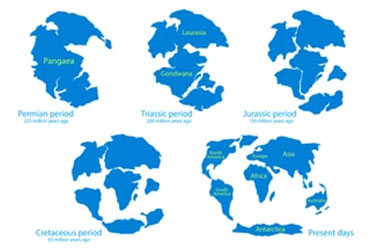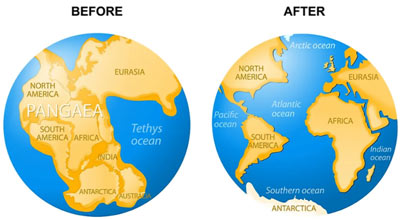Introduction
Alfred Wegener proposed the continental drift theory. According to him, “Continents were once joined together as a single supercontinent named Pangaea, which means all the Earth was ancient Greek. He proposed that supercontinent Pangaea broke up a long time ago and continents moved to their current positions.”
Alfred Wegener
Alfred Wegener was greatly impressed by the jigsaw puzzle fit of the shorelines of Africa and South America. He proposed the theory of continental drift in 1915 in the book “The Origin of Continents and Oceans”. Alfred Wegener was a meteorologist. While studying and working on past climates he observed that there are many places on Earth whose present climate does not correspond to past climate.
He observed that in some places where once the climate was extremely cold, now it is hot. There may be two reasons behind this,
- Either climate has changed, or
- The position of place has been altered.
Continental Drift Theory
To prove the point of climatic change, it needs the assumptions of many changes like that of variation in the intensity of solar radiations, the inclination of Earth’s axis, etc. which are not acceptable.
The only alternative left to explain the change in climate is by assuming the change in positions of the places or to simply put, the continental landmasses have drifted from one climatic zone to another.
Alfred Wegener believed that continents were made of comparatively lighter material called ‘Sial’ which is composed of silica and aluminium. According to him, floors of oceans were made of heavier material called ‘Sima’ which is composed of silica and magnesium. He said the lighter continents would float like icebergs, on the lower and heavier Earth crust.
Wegener’s Idea of drift
In the early Palaeozoic era, all the continents were joined to form a single great landmass “Pangaea”. It was surrounded by a vast ocean called “Panthalassa”. By the end of the Triassic period, Pangaea was divided into two supercontinents. These were northern Laurasia and southern Gondwanaland. These supercontinents began to break apart into fragments that drifted away from one another to form present-day continents.

According to Wegener, the drifting probably began soon after the Carboniferous period and continues even today. By the Eocene era, the Atlantic Ocean fully evolved separating South America and Africa. Australia and South America were still joined together through Antarctica.
Evidence of Continental Drift Theory
The continental drift theory was proposed on the basis of the following evidence:
Fossil Evidence:
Ancient fossils of the same species of extinct plants and animals are discovered in rocks of the same age but are on continents that are now far apart. Wegener cited that the organisms had lived side-by-side, yet that the lands had moved apart after they were dead as well as fossilized.
He suggested that the microorganisms would certainly not have been able to travel across the oceans. For instance, the fossils of the seed fern Glossopteris were also hefty to be brought so far by the wind. The reptile Mesosaurus was a swimming reptile but could just swim in freshwater. Cynognathus and Lystrosaurus were land reptiles and also were unable to swim.
- 64% of Carboniferous and 34% of Triassic reptilian fauna are the same for southerly continents.
The fit of Continents:
An amazing fit between the east coast of South America and the west coast of Africa was observed. Similarly, the outlines of Antarctica, Australia, and India may be grouped with each other into a cluster that suits the outlines of Africa.
Identical Geological Structures:
Similar rocks of the same type and age are located on both sides of the Atlantic Sea. Wegener said the rocks had created side-by-side which the land had since relocated apart. Mountain ranges with similar rock types, frameworks, as well as ages are currently on contrary sides of the Atlantic Sea.
The Appalachians of the eastern USA as well as Canada, for example, are much like a chain of mountains in eastern Greenland, Ireland, Great Britain, as well as Norway. Wegener ended that they developed as a solitary range of mountains that were separated as the continents drifted.
Variations of climate in the Past:
Grooves and also rock payments left by old glaciers are located today on different continents extremely near to the equator. This would certainly suggest that the glaciers either developed in the middle of the sea and/or covered a lot of the Earth. Today glaciers only base on land and nearer the poles. Wegener assumed that the glaciers were centered over the southern landmass close to the South Post as well as the continents relocated to their present positions later on.
Reef and also coal-forming swamps are located in tropical and also subtropical environments, however ancient coal seams and also reefs are located in areas where it is a lot as well cool today. Wegener recommended that these creatures were alive in warm climate areas which the fossils, as well as coal, later had actually drifted to new areas on the continents.
MCQs about Continental Drift Theory
- Who proposed the continental drift theory?
- A) Charles Darwin
- B) Alfred Wegener
- C) Isaac Newton
- D) Nikola Tesla
- Answer: B) Alfred Wegener
- When was the continental drift theory proposed?
- A) 1805
- B) 1915
- C) 1945
- D) 2000
- Answer: B) 1915
- What was the name of the supercontinent proposed by Alfred Wegener?
- A) Atlantis
- B) Pangea
- C) Gondwanaland
- D) Laurasia
- Answer: B) Pangea
- What is the composition of continental landmasses according to Wegener?
- A) Sima
- B) Water
- C) Ice
- D) Sial
- Answer: D) Sial
- What geological era saw the formation of the supercontinent Pangaea?
- A) Jurassic
- B) Carboniferous
- C) Cretaceous
- D) Triassic
- Answer: B) Carboniferous
- Which ocean surrounded the supercontinent Pangaea?
- A) Atlantic Ocean
- B) Indian Ocean
- C) Pacific Ocean
- D) Panthalassa
- Answer: D) Panthalassa
- What did Wegener suggest caused the variations in climate in the past?
- A) Change in solar radiation
- B) Movement of continents
- C) Volcanic activity
- D) Magnetic pole shifts
- Answer: B) Movement of continents
- Which evidence of continental drift theory involves the discovery of similar fossils on continents now far apart?
- A) Fossil Evidence
- B) The fit of Continents
- C) Identical Geological Structures
- D) Variations of climate in the Past
- Answer: A) Fossil Evidence
- What observation did Wegener make about the coastlines of Africa and South America?
- A) They were sinking
- B) They were expanding
- C) They showed a jigsaw puzzle fit
- D) They were identical
- Answer: C) They showed a jigsaw puzzle fit
- What did Wegener suggest was responsible for the similar rocks found on both sides of the Atlantic Ocean?
- A) Volcanic eruptions
- B) Tectonic plate movements
- C) Meteorite impacts
- D) Glacial activity
- Answer: B) Tectonic plate movements
- Which era saw the complete evolution of the Atlantic Ocean separating South America and Africa?
- A) Jurassic
- B) Eocene
- C) Paleocene
- D) Carboniferous
- Answer: B) Eocene
- What evidence of continental drift theory involves the fit between the east coast of South America and the west coast of Africa?
- A) Fossil Evidence
- B) The fit of Continents
- C) Identical Geological Structures
- D) Variations of climate in the Past
- Answer: B) The fit of Continents
- What is the composition of the ocean floors according to Wegener?
- A) Sial
- B) Sima
- C) Water
- D) Ice
- Answer: B) Sima
- Which evidence of continental drift theory involves the discovery of grooves and rock deposits left by ancient glaciers?
- A) Fossil Evidence
- B) The fit of Continents
- C) Identical Geological Structures
- D) Variations of climate in the Past
- Answer: D) Variations of climate in the Past
- What geological era saw the division of Pangaea into two supercontinents?
- A) Paleozoic
- B) Mesozoic
- C) Cenozoic
- D) Triassic
- Answer: D) Triassic
- What is the name of the vast ocean that surrounded Pangaea?
- A) Pacific Ocean
- B) Atlantic Ocean
- C) Indian Ocean
- D) Panthalassa
- Answer: D) Panthalassa
- Which evidence of continental drift theory involves the observation of similar mountain ranges on opposite sides of the Atlantic Ocean?
- A) Fossil Evidence
- B) The fit of Continents
- C) Identical Geological Structures
- D) Variations of climate in the Past
- Answer: C) Identical Geological Structures

